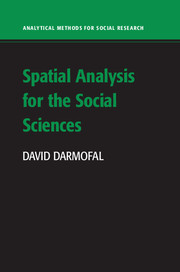Book contents
- Frontmatter
- Contents
- List of Figures
- List of Tables
- Preface
- PART I GENERAL TOPICS
- 1 The Social Sciences and Spatial Analysis
- 2 Defining Neighbors via a Spatial Weights Matrix
- 3 Spatial Autocorrelation and Statistical Inference
- 4 Diagnosing Spatial Dependence
- 5 Diagnosing Spatial Dependence in the Presence of Covariates
- 6 Spatial Lag and Spatial Error Models
- 7 Spatial Heterogeneity
- PART II ADVANCED TOPICS
- PART III APPENDICES ON IMPLEMENTING SPATIAL ANALYSES
- Glossary
- Bibliography
- Index
7 - Spatial Heterogeneity
from PART I - GENERAL TOPICS
Published online by Cambridge University Press: 05 November 2015
- Frontmatter
- Contents
- List of Figures
- List of Tables
- Preface
- PART I GENERAL TOPICS
- 1 The Social Sciences and Spatial Analysis
- 2 Defining Neighbors via a Spatial Weights Matrix
- 3 Spatial Autocorrelation and Statistical Inference
- 4 Diagnosing Spatial Dependence
- 5 Diagnosing Spatial Dependence in the Presence of Covariates
- 6 Spatial Lag and Spatial Error Models
- 7 Spatial Heterogeneity
- PART II ADVANCED TOPICS
- PART III APPENDICES ON IMPLEMENTING SPATIAL ANALYSES
- Glossary
- Bibliography
- Index
Summary
Spatial autocorrelation that is diagnosed may be produced neither by a diffusion process nor by an attributional process. Instead, it may be produced by behavioral heterogeneity. Within a modeling context, this will take the form of spatial heterogeneity in parameters. If this parameter heterogeneity is not modeled, spatial dependence will persist in the presence of covariates. Residual spatial dependence in a multivariate model may also be produced by another undiagnosed form of spatial heterogeneity – functional form heterogeneity. Depending on the modeling strategy employed to account for spatial heterogeneity in parameters or functional form, a spatial econometric specification may not be required to model the spatial heterogeneity. Instead, the researcher may choose to model the spatial heterogeneity via standard econometric approaches.
SPATIAL HETEROGENEITY IN PARAMETERS
The intuition of how spatial heterogeneity in parameters may produce univariate spatial autocorrelation is straightforward. If a covariate differs in its effects on the phenomenon of interest to social scientists across observations, and if the effects are similar among neighboring observations, this may produce similar values on the dependent variable. I examine three sets of approaches for modeling spatial heterogeneity in parameters – spatial random coefficients models, spatial switching regressions models for discrete parameter heterogeneity, and spatially varying coefficients models for continuous parameter heterogeneity – in turn next.
SPATIAL RANDOM COEFFICIENTS MODELS
Random coefficients models have received extensive use in econometrics as an approach for modeling heterogeneity in parameters (Swamy 1970; Hsiao 1975). The standard, nonspatial random coefficients specification takes the following form:
yi = Xiβi +εi
βi = β +μi,
where βi is no longer assumed constant, but instead is allowed to vary across observations as a function of a mean, β, and a stochastic term, μi. The random coefficients model induces heteroskedasticity, which is modeled via feasible generalized least squares (FGLS).
In the standard random coefficients model, the stochastic variation, μi, around the common mean, β, is assumed to be random with regard to the spatial locations of observations. In contrast, in the spatial random coefficients approach, there is spatial dependence in this variation around the mean.
- Type
- Chapter
- Information
- Spatial Analysis for the Social Sciences , pp. 119 - 138Publisher: Cambridge University PressPrint publication year: 2015

